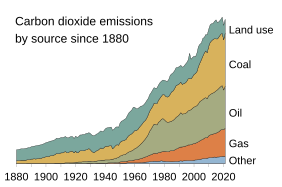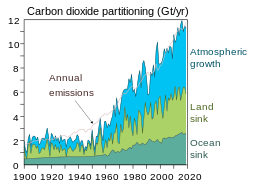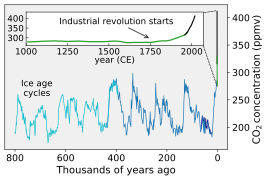Atmospheric carbon cycle

The atmospheric carbon cycle accounts for the exchange of gaseous
Human activities, primarily the extraction and burning of
The atmospheric carbon cycle also strongly influences
Relevant gases
| Part of a series on the |
| Carbon cycle |
|---|
 |
The atmosphere is one of the Earth's major carbon reservoirs and holds approximately 720 gigatons of carbon as of year 2000.[2] The concentration of mostly carbon-based greenhouse gases has increased dramatically since the onset of the industrial era. This makes an understanding of the carbon component of the atmosphere highly important. The two main carbon greenhouse gases are methane and carbon dioxide.[10]
Methane
Methane (CH4) is one of the more potent greenhouse gases and is mainly produced by the digestion or decay of biological organisms. It is considered the second most important greenhouse gas,[10] yet the methane cycle in the atmosphere is currently only poorly understood.[11] The amount of methane produced and absorbed yearly varies widely.[10]
Large stores of methane can be found in the form of methane ice under permafrost and on continental shelves. Additional methane is produced by the anaerobic decay of organic material and is produced in organisms' digestive tracts, soil, etc. Natural methane production accounts 10-30% of global methane sources.[12]
Anthropogenic methane is produced in various ways, e.g. by raising cattle or through the decay of trash in landfills. It is also produced by several industrial sources, including the mining and distribution of fossil fuels.
Methane can be removed from the atmosphere through a reaction of the photochemically produced
Carbon dioxide

Carbon dioxide (
Interactions with other systems
| Part of a series on |
| Biogeochemical cycles |
|---|
 |

Atmospheric carbon is exchanged quickly between the oceans and the terrestrial biosphere. This means that at times the atmosphere acts as a sink, and at other times as a source of carbon.[2] The following section introduces exchanges between the atmospheric and other components of the global carbon cycle.
Terrestrial biosphere
Carbon is exchanged with varying speed with the terrestrial biosphere. It is absorbed in the form of carbon dioxide by
The residence time of carbon in the terrestrial biosphere varies and is dependent on a large number of factors. The uptake of carbon into the biosphere occurs on various time scales. Carbon is absorbed primarily during plant growth. A pattern of increased carbon uptake is observable both over the course of the day (less carbon is absorbed at night) and over the course of the year (less carbon is absorbed in winter).[10] While organic matter in animals generally decays quickly, releasing much of its carbon into the atmosphere through respiration, carbon stored as dead plant matter can stay in the biosphere for as much as a decade or more. Different plant types of plant matter decay at different rates - for example, woody substances retain their carbon longer than soft, leafy material.[20] Active carbon in soils can stay sequestered for up to a thousand years, while inert carbon in soils can stay sequestered for more than a millennium.[19]
Oceans
Each year, the ocean and atmosphere exchange large amounts of carbon. A major controlling factor in oceanic-atmospheric carbon exchange is
Biological processes also lead to ocean-atmosphere carbon exchange. Carbon dioxide equilibrates between the atmosphere and the ocean's surface layers. As autotrophs add or subtract carbon dioxide from the water through photosynthesis or respiration, they modify this balance, allowing the water to absorb more carbon dioxide or causing it to emit carbon dioxide into the atmosphere.[2]
Geosphere
Carbon is generally exchanged very slowly between the atmosphere and geosphere. Two exceptions are
Anthropogenic sources
Human activities change the amount of carbon in the atmosphere directly through the burning of fossil fuels and other organic material, thus
Other human-caused changes in the atmospheric carbon cycle are due to anthropogenic changes to carbon reservoirs. Deforestation, for example, decreases the biosphere's ability to absorb carbon, thus increasing the amount of carbon in the atmosphere.[24]
As the industrial use of carbon by humans is a very new dynamic on a geologic scale, it is important to be able to track sources and sinks of carbon in the atmosphere. One way of doing so is by observing the proportion of stable carbon isotopes present in the atmosphere. The two main carbon isotopes are 12C and 13C. Plants absorb the lighter isotope, 12C, more readily than 13C.[25] Because fossil fuels originate mainly from plant matter, the 13C/12C ratio in the atmosphere falls when large amounts of fossil fuels are burned, releasing 12C. Conversely, an increase in the 13C/12C in the atmosphere suggests a higher biospheric carbon uptake.[19] The ratio of the annual increase in atmospheric CO2 compared to CO2 emissions from fossil fuel and cement manufactured is called the "airborne fraction.".[26] The airborne fraction has been around 60% since the 1950s, indicating that about 60% of the new carbon dioxide in the atmosphere each year originated from human sources.[10] For clarity, this is not meant to suggest that 60% of the uptake of carbon dioxide into the atmosphere comes from human activity. It means that the atmosphere exchanges around 210 gigatonnes of carbon annually, but absorbs between 6 and 10 gigatonnes more than it loses. Of this net gain, about 60% is attributable to the burning of fossil fuels.
Gallery
-
Atmospheric CO2 concentrations over the last 800,000 years as measured from ice cores (blue/green) and directly (black).
-
Ocean and land sinks have taken up about half of fossil carbon emissions into the atmosphere. It's uncertain how long this will continue.[27]
-
CO2 flows from human activity (left) into atmosphere, land, and ocean sinks (right).[5]
-
Anthropogenic carbon flows during years 1850-2018 (left) and 2009-2018 (right).[5]
References
- ISSN 1866-3516.
- ^ PMID 11030643.
- ^ Riebeek, Holli (16 June 2011). "The Carbon Cycle". Earth Observatory. NASA. Archived from the original on 5 March 2016. Retrieved 5 April 2018.
- .
- ^ doi:10.5194/essd-11-1783-2019..
 Material was copied from this source, which is available under a Creative Commons Attribution 4.0 International License
Material was copied from this source, which is available under a Creative Commons Attribution 4.0 International License - ^ IPCC / Cambridge University Press. Archived(PDF) from the original on 2021-08-13. Retrieved 2021-08-09.
- ^ a b Tans, Pieter; Keeling, Ralph. "Trends in Carbon Dioxide". NOAA Earth System Research Laboratory.
- ^ "What is Ocean Acidification?". National Ocean Service, National Oceanic and Atmospheric Administration. Retrieved 2020-10-30.
- ^ A Year In The Life Of Earth’s CO2 NASA: Goddard Space Flight Center, 17 November 2014.
- ^ a b c d e f g h Forster, P.; Ramawamy, V.; Artaxo, P.; Berntsen, T.; Betts, R.; Fahey, D.W.; Haywood, J.; Lean, J.; Lowe, D.C.; Myhre, G.; Nganga, J.; Prinn, R.; Raga, G.; Schulz, M.; Van Dorland, R. (2007), "Changes in atmospheric constituents and in radiative forcing", Climate Change 2007: The Physical Basis. Contribution of Working Group I to the Fourth Assessment Report of the Intergovernmental Panel on Climate Change
- ^ a b c Prather, M.; et al. (2001), "Atmospheric chemistry and greenhouse gases", Climate Change 2001: The Scientific Basis. Contribution of Working Group I to the Third Assessment Report of the Intergovernmental Panel on Climate Change
- S2CID 2870347.
- ^ a b Global Observing Systems Information Center (2011). "GCOS Atmospheric Composition ECV: Methane (CH4) and other Long-Lived Green House Gases". Archived from the original on 2012-03-08. Retrieved 2012-06-04.
- .
- .
- .
- .
- ^ a b Denman, Kenneth; Brasseur, Guy; Chidthaisong, A.; Ciais, P.; Cox, P.; Dickinson, R..; Hauglustaine, D.; Heinze, C.; Holland, E.; Jacob, D.; Lohmann, U.; Ramachandran, S.; da Silva Dias, P.; Wofsy, S.; Zhang, X. (2007), "Couplings between changes in the climate system and biogeochemistry", Climate Change 2007: The Physical Basis. Contribution of Working Group I to the Fourth Assessment Report of the Intergovernmental Panel on Climate Change
- ^ a b c d Prentice, I. C.; et al. (2001). "The carbon cycle and atmospheric carbon dioxide" (PDF). Climate Change 2001: The Scientific Basis. Contribution of Working Group I to the Third Assessment Report of the Intergovernmental Panel on Climate Change: 184–238. Retrieved 2020-06-20.
- ISBN 978-87-403-0197-7.
- ^ "Carbon Cycle and Atmospheric CO2 | Earth 530: The Critical Zone". www.e-education.psu.edu. Retrieved 2023-10-08.
- S2CID 21618974.
- .
- .
- .
- S2CID 4238247.
- ^ Lynch, Patrick (12 November 2015). "GMS: Carbon and Climate Briefing - 12 November 2015". National Aeronautics and Space Administration. Goddard Media Studios. Retrieved 7 November 2018.




![Ocean and land sinks have taken up about half of fossil carbon emissions into the atmosphere. It's uncertain how long this will continue.[27]](http://upload.wikimedia.org/wikipedia/commons/thumb/0/09/Carbon_dioxide_emissions_global_carbon_cycle.jpg/240px-Carbon_dioxide_emissions_global_carbon_cycle.jpg)
![CO2 flows from human activity (left) into atmosphere, land, and ocean sinks (right).[5]](http://upload.wikimedia.org/wikipedia/commons/thumb/1/19/Global_carbon_budget_components.png/143px-Global_carbon_budget_components.png)
![Anthropogenic carbon flows during years 1850-2018 (left) and 2009-2018 (right).[5]](http://upload.wikimedia.org/wikipedia/commons/thumb/a/aa/Anthropogenic_carbon_flows_1850-2018.png/165px-Anthropogenic_carbon_flows_1850-2018.png)